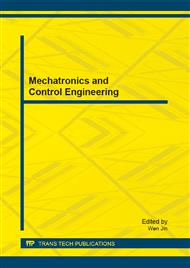p.125
p.131
p.137
p.143
p.147
p.153
p.157
p.163
p.167
Design of the Assistive Leg and the Simulation Research
Abstract:
The wearable assistive leg is a kind of traditional exoskeleton device, which not only can help healthy people with walking, but also can assist those who have walking troubles to rehabilitate. Based on the bionics principle and the research on the body mechanism, a wearable assistive leg for rehabilitation training and power augmentation is designed. This device satisfies the requirement of the compact structure, portability and safety. Then the dynamic model of the assistive leg is constructed based on the Lagrange theory. The mechanical structure is devised by Solidworks2011 software in which a standard human body model and this assistive leg are assembled. Thus the assembly is introduced into Adams2007 R3. The dynamics simulation is carried in this software. The results and the existing problems are analyzed. The simulation results show that this kind of assistive leg can provide helping force for human lower extremity movements.
Info:
Periodical:
Pages:
147-152
Citation:
Online since:
July 2013
Authors:
Keywords:
Price:
Сopyright:
© 2013 Trans Tech Publications Ltd. All Rights Reserved
Share:
Citation:


